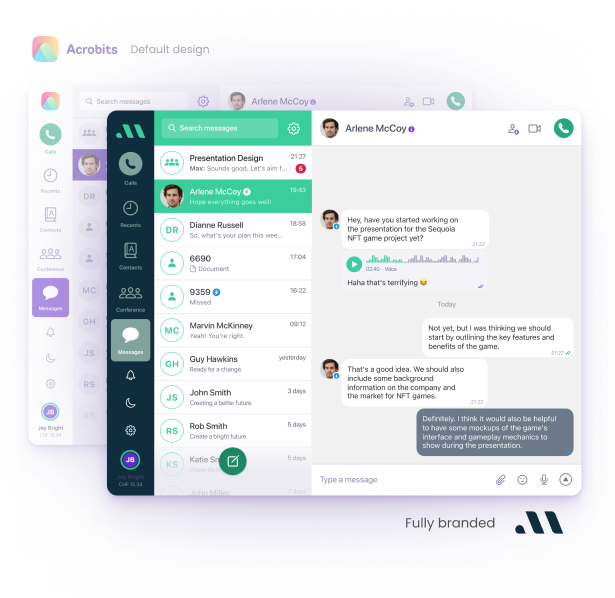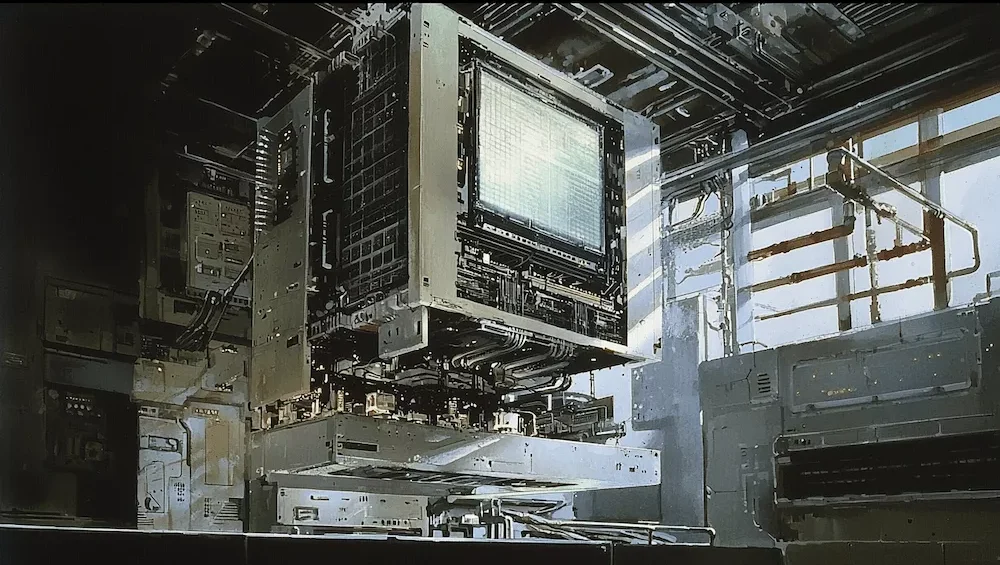
Build a white label softphone app
Create a custom white-label softphone with Cloud Softphone.
- No devs needed
- Native desktop apps
- 100+ premium features

What should telecommunications providers do both now and in the future? That’s the question industry all industry professionals are asking.
With so much set to change in 2025 — you’ll want to follow these top telecom trends. Here’s where we see the industry going in 2025, including top trends, challenges, and innovations.

We saw AI and ML grow by significant leaps in 2024, and now, many industries, telecom included, are exploring how to apply these advancements throughout their operations.
AI will undoubtedly be one of the most impactful telecom trends for 2025. The initial excitement has settled down, and specific use cases are now being explored, all while the underlying technologies continue to grow.
AI models excel at identifying underlying patterns in data that may be overlooked by even highly trained personnel. Predictive analytics and maintenance is one way this unique ability can be leveraged, giving engineers and technicians more significant insights into when hardware and software need attention to avoid downtime. Once deployed, these tools can save time, reduce time, and improve overall performance.
Similar to predictive analytics’ ability to identify patterns, purpose-built models can identify choke points and inefficiencies throughout a company’s network.
From there, recommendations can be made, or traffic can be routed on-demand to better utilize available resources. We’ll likely see a new level of optimization automation that creates lower-latency services.
We’ve already seen advanced chatbots in nearly every industry, and for a good reason: they help customers find answers easier and faster.
Older chatbots often fail to understand inquiries and offer dynamic support, but now, many basic to intermediate support issues can be solved without a human agent. Customers can find resolutions faster, while your agents can focus on more complex issues.
We’ve said it before, but it bears mentioning again. Generative AI is a transformative technology with universal potential. Even lower-priority areas have the potential to benefit from the technology through incremental improvements in operational efficiency.
AI is becoming integral to telecom operations, enhancing network optimization, customer service, and predictive maintenance alongside more efficient data management and service personalization.
We’re also seeing a stronger focus on machine learning, specifically when it comes to identifying patterns in network performance, consumer behavior, and other strategic avenues.
If you want to leverage this potential, acting early is critical — implementing it prior to competitors will give you a significant lead.
More favorable access terms would be a good starting point. Governments might also consider rationing and allocating spectrum resources through spectrum scales or working with telecom providers to create new operators.
Providers, meanwhile, can leverage economies of scale not just through mergers but also through strategic partnerships that allow them to make the most of their investments.
To call the current telecommunications landscape volatile would be putting it lightly. In PwC’s 27th Annual Global CEO Survey, 52% of telecom CEOs felt their company would no longer be economically viable a decade from now if it continues on its current path.
Another PwC study conducted the previous year paints a picture of a market landscape that varies in both price and competition.
High ARPU spread indicates strong differentiation, while low spread highlights commoditization. Markets dominated by a few players face numerous challenges when it comes to sustaining pricing power, necessitating new innovation and growth strategies. Industry consolidation is one route being explored by major operators like Vodafone, Altice, Liberty Global, and Iliad.
Rising costs, labor shortages, growing debt, high regulatory scrutiny and complex competitive legislation alongside mounting infrastructure investment requirements have together created something of a logistical and budgetary nightmare for telecom providers.
Strategic M&A activities such as Masmovil-Orange and the merger between Vodafone and Hutchison are intended to increase operational efficiency and network investments.
Yet these do very little to reduce competitive pressures. Even in places like Spain, where three large operators account for nearly 90% of the telecom market, pricing competition remains intense.
And amidst growing concerns about national security, economic interests and technological sovereignty, governments are increasingly intervening in critical infrastructure deals.
In some cases, stakeholder resistance is a roadblock as well — Vodafone, for instance, rejected two merger proposals from Iliad in December 2023 and January 2024, noting that it was exploring other options in the Italian market.
More favorable access terms would be a good starting point. Governments might also consider rationing and allocating spectrum resources through spectrum scales or working with telecom providers to create new operators.
Providers, meanwhile, can leverage economies of scale not just through mergers but also through strategic partnerships that allow them to make the most of their investments.

Quantum technology represents an exciting frontier for telecommunications providers. Quantum cryptography, for instance, could future-proof networks and protect them against an entirely new generation of cyberattack. Applying quantum computing to network operations, meanwhile, could revolutionize infrastructure.
Multiple pilot projects to assess the potential of quantum technology are already underway. In order to fully realize that potential, however, telecom providers will first need to overcome a few challenges. Quantum technology may be powerful, but it also comes with some considerable shortcomings.
First, quantum systems tend to struggle with environmental interference, resulting in a high error rate. Quantum computers are also more difficult to deploy and scale compared to more traditional infrastructure. Moreover, because quantum technology is so new, hardware development is also a challenge, to say nothing of the cost and complexity involved where integration is concerned.
Quantum technology also suffers from many of the same stumbling points as AI, including a limited workforce and a lack of standardization.
All we can really do at this point is wait. Quantum technology is still incredibly new, so growing pains are inevitable. The industry will overcome them, given enough time.

The rise of high-performance satellite internet networks like Starlink will continue to change the way consumers access the Internet in hard-to-reach areas. This will bring more underserved consumers online.
There’s no denying billionaire Elon Musk’s direct access to President Donald Trump and the White House should prove favorable as the company looks to expand.
Additionally, we may even see a transition from networks being on-demand to a more as-a-service model. eSIM technology is already driving this change forward.
What does this mean? Simply put, consumers may no longer be tied to a single network or operator, but rather the “service” itself, giving them reliable coverage when and where they need it.
One of the critical new trends in telecommunication is a push for disaggregation and virtualization at the telecom provider level. This trend has the potential to dramatically transform the world of telecommunications by maximizing available infrastructure and enhancing uptime.
There are plenty of technologies working towards this goal, but two key technologies to highlight are:
The technology decouples hardware and network functions. For example, routers, load balancers, and firewalls are often handled by physical hardware.
NFV aims to virtualize this hardware to run on standard hardware like servers used for cloud computing. The possible benefits are cutting costs, improving scalability, and faster deployment.
SDN uses software controllers and APIs to direct traffic on the network while also communicating with the underlying hardware. The goal is to separate the network’s control and infrastructure to enable a higher degree of automation and management efficiency.
Several countries, including Canada, the United Kingdom, and the European Union, have together set an ambitious goal: full gigabit broadband coverage by 2030. As you might expect, that’s easier said than done.
Rising labor costs and interest rates are a major concern, as is the high cost of deployment in rural areas. Lagging regions like Germany and the UK will also need to significantly increase the rate of deployment compared to other areas.
First and foremost, public-private partnerships could help close the investment gap, with investors providing much-needed capital. Alternative connectivity solutions like fixed wireless access and satellite Internet in remote areas are also possible to offer reliable connectivity to underserved areas.
Diversifying telecom networks to enhance uptime, resilience to natural disasters, and provide reliable services is a critical focus of telecom.
We saw plenty of recommendations for signing up with two or more providers in an attempt to improve communication reliability, but this puts the focus on carrier diversity — not network diversity.
True network diversity depends on choosing the right provider that continually focuses on diversifying your services in the back end.
The core of network diversity is building redundant routes to your location, staying aware of any outages to take immediate action, and minimizing any user-affecting issues.
While we think having a focus on diversifying networks to improve reliability, make sure you shift away from the 2023 trend of signing up with multiple carriers and instead focus on checking with your existing carrier about how they’re working on network diversity.
Companies will need to rethink how they approach redundancy and business continuity. For many, this means having multiple vendors to provide failover during outages, natural disasters, and other challenging environments.
It’s no secret big tech is working towards an integrated future. After all, we live in the API economy now where integration is everything.
Of course, some companies, like Apple, have tried to fight this trend. However, even Apple threw in the towel on its proprietary messaging service when it agreed to embrace the Rich Communication Services (RCS) messaging standard.
While seemingly small, this represents an important step in the right direction, as it introduces iMessage-style messaging features for Apple and Android users.
There will be a bigger focus on cross-platform development as Apple and Android continue to unify core messaging capabilities across mobile devices, smartphones, and integrated smart devices.
Between increasingly energy-hungry applications like artificial intelligence and the growing energy needs of 5G infrastructure, the energy demands of the telecommunication sector have been increasing exponentially. This has caused a resultant increase in Scope 3 emissions across telecom supply chains.
Regulatory requirements and increased focus on social responsibility are also driving factors.
The good news is that operators like Deutsche Telekom, Telia, and Tele2 are already transitioning to sustainable energy sources, leading the green energy adoption among industries.
We’re also seeing copper networks being decommissioned in favor of energy-efficient fiber networks. These innovations are only the start, though.
Simple: Continued investment into green energy. Beyond that, deploying smart energy-saving measures like network optimization and intelligent automation will go a long way toward improving sustainability.
We mentioned regulation and legislation as a major roadblock for both artificial intelligence and quantum computing. Let’s discuss in a bit more depth some of the challenges and roadblocks in that arena.
At the moment, there are several regulatory initiatives such as the Digital Markets Act, Digital Services Act, and AI Act aiming to harmonize telecom rules while also leveling the playing field between telecom and tech companies.
The regulations resulting from these initiatives tend to have high compliance costs. Moreover, balancing consumer privacy with business needs under ePrivacy regulations is extremely challenging.
Cross-border mergers can help telecommunications providers achieve the necessary scale and reach to address some of the more complex regulatory challenges.
Beyond that, encouraging interoperability and fair competition between providers can help reduce the need for government intervention and complex regulatory frameworks.

Driven by improved standards and affordable devices, the past few years have seen the mass adoption of smart home technologies.
This represents an enormous opportunity for telecommunications providers: A new line of business through which they can both improve customer satisfaction and reduce churn. All they need to do is resell and support smart home products.
Simple, right?
Not exactly. Many IoT systems are developed and manufactured by companies entirely unfamiliar with the technical aspects of networking. Ensuring interoperability and security can, as a result, be a bit of a nightmare.
Telecom providers can first and foremost focus on enhancing network reliability and safety. They might also consider offering bundled smart home services.
Finally, there’s the possibility of collaborating with smart home vendors, giving them access to technical expertise they may lack internally.
The vast digital ecosystems we’ve created through technologies like the Internet of Things are a veritable playground for threat actors.
Cyberattacks are at an all-time high, especially phishing attacks and ransomware. To make matters worse, cybercriminals have access to increasingly sophisticated tools, including artificial intelligence.
Broad reliance on outdated devices with poor security features only exacerbates the problem. Believe it or not, this is another opportunity for telecom operators — the opportunity to expand into cybersecurity services.
By collaborating with security vendors, telecom operators could not only promote secure mobile devices and software, but also offer value-added services such as endpoint protection, antivirus, and virtual private networking.
The telecom industry’s currently witnessing a convergence of wireless and wireline services. Telecom companies, recognizing the opportunity this presents, are integrating their offerings to provide more seamless connectivity solutions.
They’ve also begun exploring new business models to drive growth, such as investing in fiber-optic networks to meet increasing data demands.
This trend is best exemplified by another trend we’ve already mentioned — mergers and acquisitions aimed at expanding solutions portfolios. The only real solution here is for providers to continue exploring new services, service offerings, and lines of business.
That said, it may also be worthwhile to further increase investment into network infrastructure to account for surging demand triggered by computing-intensive applications such as generative AI.

The deployment of 5G and 5.5G networks continues to accelerate, providing faster, more reliable connectivity. This expansion not only supports emerging technologies such as IoT and autonomous systems, but also paves the way for new applications and services.
According to the Ericsson Mobility Report, 5G technology is expected to reach a global penetration of 85% by 2029 — just in time for 6G to become viable, if predictions hold true.
Again, though, there are going to be some growing pains. Variability in speed improvements is an ongoing concern due to differences in network quality, spectrum availability, and regional infrastructure.
The high energy requirements of 5G may also be an issue, especially if it’s used to support high-intensity processes such as AI.
More efficient spectrum allocation and auctioning would be a good start. Standalone 5G networks may also enhance performance. Finally, 5.5G and 6G both have the potential to address any issues regarding limited bandwidth.
A company’s level of innovation is typically based on three factors: Ease of adoption, level of disruption, and competitive necessity.
That doesn’t mean a solution needs to be disruptive and challenging to adopt in order to be impactful, however. Something like contract management or software development and testing can, if deployed effectively, have an enormous impact.
It’s all in how you approach it — and how you view the future.
Ready to future-proof your communications? Reach out to us today to learn more about how we can prepare you for 2025 and beyond.

Let us start by saying that 5G technology is still going to be transformative. There’s no denying that. But the rollout of 5G technology hasn’t exactly gone according to plan. First of all, what is it? What Is 5G? And What Does It Offer? As its name suggests, 5G is the fifth generation of the […]

5G isn’t that far away anymore. Mass adoption throught the globe is already a thing, In the third quarter of 2023 alone, Ericsson reported that 5G subscriptions with a 5G-capable device grew by 163 million to reach approximately 1.4 billion globally. International Data Corp’s. (IDC) “U.S. 5G Smartphone Forecast, 2023-2027” forecasts that by 2027, 155.0 […]

Remember when 4G launched and everyone said it’d change the way we communicate? You know, that same technology CNN proclaimed would “change your life.” In many ways, 4G did change the way we communicate. It made smartphones more accessible and laid the foundation for the many communication methods we still use today. Well, times are […]